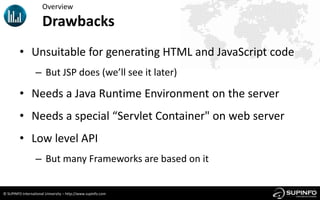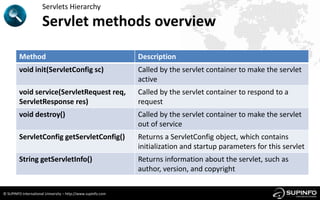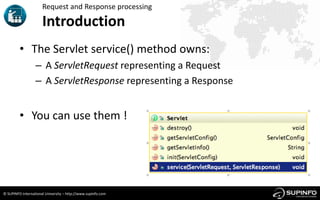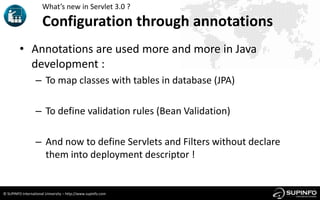Java EE - Servlets API
- 1. Servlets Java Web Applications © SUPINFO International University – http://www.supinfo.com
- 2. Servlets Course objectives By completing this course you will be able to: – Explain what a servlet is – Describe the Servlet API – Create basic and advanced servlets – Enumerate the main new features in Servlet 3.0 © SUPINFO International University – http://www.supinfo.com
- 3. Servlets Course plan – Introduction – Servlet hierarchy – Request and response processing – Deployment descriptor – The Web Container Model – What’s new in Servlet 3.0? © SUPINFO International University – http://www.supinfo.com
- 4. Servlets OVERVIEW © SUPINFO International University – http://www.supinfo.com
- 5. Overview Presentation • Classes executed on the server • Dynamic request processing • Dynamic response producing • Generally used on a Web server © SUPINFO International University – http://www.supinfo.com
- 6. Overview Advantages • Efficient : – JVM’s memory management – Only one instance per Servlet – One request = One Thread – … • Useful : – Cookies – Sessions –… © SUPINFO International University – http://www.supinfo.com
- 7. Overview Advantages • Extensible and flexible : – Run on numerous platforms and HTTP servers without change – Enhanced by many frameworks • Java Language ! (powerful, reliable with a lot of API) © SUPINFO International University – http://www.supinfo.com
- 8. Overview Drawbacks • Unsuitable for generating HTML and JavaScript code – But JSP does (we’ll see it later) • Needs a Java Runtime Environment on the server • Needs a special “Servlet Container" on web server • Low level API – But many Frameworks are based on it © SUPINFO International University – http://www.supinfo.com
- 9. Overview Dynamic process • Basic HTTP request handling – Static HTML ≠ • Servlet request handling – Dynamic response generated © SUPINFO International University – http://www.supinfo.com
- 10. Overview Basic request 1. Connection and request from client 2. Look for the target 3. Page transferred to the client then disconnection © SUPINFO International University – http://www.supinfo.com
- 11. Overview Servlet request – First call 1. Connection and request from client 2. Servlet is created and initialized by init() method 3. Servlet executes service() method 4. Response transferred then disconnection © SUPINFO International University – http://www.supinfo.com
- 12. Overview Servlet request – Other calls 1. Connection and request from client 2. Servlet executes service() method 3. Response transferred then disconnection © SUPINFO International University – http://www.supinfo.com
- 13. Overview Servlet Container • Servlet container implements the web component contract of the Java EE architecture • Also known as a web container • Examples of Servlet containers are : – Tomcat – Jetty – Oracle iPlanet Web Server © SUPINFO International University – http://www.supinfo.com
- 14. Overview Servlet-Based frameworks • Few companies used Servlet technology alone… – But a lot of companies used Servlet-based Frameworks ! – A large number exists : • Struts • JSF • Spring MVC • Wicket • Grails • … © SUPINFO International University – http://www.supinfo.com
- 15. Overview Servlet-Based frameworks © SUPINFO International University – http://www.supinfo.com
- 16. Questions ? © SUPINFO International University – http://www.supinfo.com
- 17. Servlets SERVLET HIERARCHY © SUPINFO International University – http://www.supinfo.com
- 18. Servlet Hierarchy Presentation • Servlet hierarchy is mainly composed of : – Servlet interface – GenericServlet abstract class – HttpServlet abstract class © SUPINFO International University – http://www.supinfo.com
- 19. Servlet Hierarchy Servlet interface • Defines methods a servlet must implement : – How the servlet is initialized? – What services does it provide? – How is it destroyed? –… © SUPINFO International University – http://www.supinfo.com
- 20. Servlets Hierarchy Servlet methods overview Method Description void init(ServletConfig sc) Called by the servlet container to make the servlet active void service(ServletRequest req, Called by the servlet container to respond to a ServletResponse res) request void destroy() Called by the servlet container to make the servlet out of service ServletConfig getServletConfig() Returns a ServletConfig object, which contains initialization and startup parameters for this servlet String getServletInfo() Returns information about the servlet, such as author, version, and copyright © SUPINFO International University – http://www.supinfo.com
- 21. public class MyServlet implements Servlet { Servlet Example 1/2 private ServletConfig config; @Override public void init(ServletConfig sc) { this.config = sc; } @Override public ServletConfig getServletConfig() { return this.config; } ... © SUPINFO International University – http://www.supinfo.com
- 22. ... @Override Servlet Example 2/2 public String getServletInfo() { return "MyServlet is the best !!"; } @Override public void service(ServletRequest req, ServletResponse res) { res.getWriter().println("Hello world"); } @Override public void destroy() { /* ... */ } } © SUPINFO International University – http://www.supinfo.com
- 23. Servlet Hierarchy GenericServlet class • An independent-protocol Servlet – Implements : • Servlet • ServletConfig • Implementations just need to define the service method © SUPINFO International University – http://www.supinfo.com
- 24. Servlet Hierarchy GenericServlet class example public class MyServlet extends GenericServlet { @Override public void service(ServletRequest req, ServletResponse res) { // Do whatever you want } } © SUPINFO International University – http://www.supinfo.com
- 25. Servlet Hierarchy HttpServlet class • A Servlet suitable for Web sites • Handles HTTP methods : – GET requests with doGet(…) – POST requests with doPost(…) – PUT requests with doPut(…) – Etc… • You can override one or several of them © SUPINFO International University – http://www.supinfo.com
- 26. Servlet Hierarchy HttpServlet class • How does it work? request Get doGet() request Post service() doPost() Client HttpServlet Be Careful: doGet(), doPost() and others, are called by the HttpServlet implementation of the service() method. If it is overridden, the HTTP handler methods will not be called! © SUPINFO International University – http://www.supinfo.com
- 27. Servlets Hierarchy HttpServlet • Methods overview: Method Description Receives standard HTTP requests and void service(HttpServletRequest req, dispatches them to the doXXX methods HttpServletResponse res) defined in this class void doGet(HttpServletRequest req, Handles GET requests HttpServletResponse res) void doPost(HttpServletRequest req, Handles POST requests HttpServletResponse res) … … © SUPINFO International University – http://www.supinfo.com
- 28. public class MyServlet extends HttpServlet { HttpServlet example @Override public void doGet(HttpServletRequest req, HttpServletResponse res) { // Do whatever you want } @Override public void doPost(HttpServletRequest req, HttpServletResponse res) { // Do whatever you want here too ... } } © SUPINFO International University – http://www.supinfo.com
- 29. Questions ? © SUPINFO International University – http://www.supinfo.com
- 30. Servlets REQUEST AND RESPONSE PROCESSING © SUPINFO International University – http://www.supinfo.com
- 31. Request and Response processing Introduction • The Servlet service() method owns: – A ServletRequest representing a Request – A ServletResponse representing a Response • You can use them ! © SUPINFO International University – http://www.supinfo.com
- 32. Request and Response processing ServletRequest • Objects defined to provide client request information to a servlet • Useful to retrieve : – Parameters – Attributes – Server name and port – Protocol – … © SUPINFO International University – http://www.supinfo.com
- 33. Request and Response processing ServletRequest • Methods overview: Method Description String getParameter(String name) Return the request parameter(s) Map<String, String[]> getParameterMap() Object getAttribute() Retrieves/Stores an attribute from/to void setAttribute(String name, Object value) the request Indicates if the request was made using boolean isSecure() a secure channel such as HTTPS © SUPINFO International University – http://www.supinfo.com
- 34. Request and Response processing ServletRequest • Methods overview: Method Description String getServerName() Get the server name and port int getServerPort() String getRemoteAddr() Get the address, the hostname and the port of String getRemoteHost() the client int getRemotePort() © SUPINFO International University – http://www.supinfo.com
- 35. Request and Response processing HttpServletRequest • Dedicated to HTTP Requests • Useful to retrieve : – The session associated to the request – The headers of the request – Cookies – … © SUPINFO International University – http://www.supinfo.com
- 36. Request and Response processing HttpServletRequest • Methods overview: Method Description HttpSession getSession() Returns the session associated to the HttpSession getSession(boolean create) request String getHeader(String name) Returns the value of the specified header Cookie[] getCookies() Get the cookies sent with the request © SUPINFO International University – http://www.supinfo.com
- 37. Request and Response processing ServletResponse • Objects defined to assist a servlet in sending a response to the client • Useful to retrieve : – The output stream of the response – A PrintWriter –… © SUPINFO International University – http://www.supinfo.com
- 38. Request and Response processing ServletResponse • Methods overview: Method Description Returns the output stream of the servlet. ServletOutputStream getOutputStream() Useful for binary data. Returns a writer, useful to send textual PrintWriter getWriter() response to the client Defines the mime type of the response void setContentType(String content) content, like "text/html" Be Careful: You can’t use getOutputStream() and getWriter() together. Calling both in a servlet gets an IllegalStateException. © SUPINFO International University – http://www.supinfo.com
- 39. Request and Response processing HttpServletResponse • Dedicated to HTTP Responses • Useful to : – Add cookies – Redirect the client –… © SUPINFO International University – http://www.supinfo.com
- 40. Request and Response processing HttpServletResponse • Methods overview: Method Description void addCookie(Cookie c) Add a cookie to the response void sendRedirect(String location) Redirect the client to the specified location © SUPINFO International University – http://www.supinfo.com
- 41. public class MyServlet extends HttpServlet { PrintWriter Example @Override protected void doGet(HttpServletRequest req, HttpServletResponse resp) { String name = req.getParameter("name"); resp.setContentType("text/html"); PrintWriter out = resp.getWriter(); out.println("<html>"); out.println("<head>"); out.println("<title>My Servlet</title>"); out.println("</head>"); out.println("<body>"); out.println("<h1>Hello " + name + " !</h1>"); out.println("</body>"); out.println("</html>"); } } © SUPINFO International University – http://www.supinfo.com
- 42. Questions ? © SUPINFO International University – http://www.supinfo.com
- 43. Servlets DEPLOYMENT DESCRIPTOR I’ve got my servlet, and now? © SUPINFO International University – http://www.supinfo.com
- 44. Deployment descriptor Introduction • A Servlet application has always (or almost) a deployment descriptor : – /WEB-INF/web.xml • It defines : – The servlets classes - The welcome files – The servlets mappings - The application resources – The filters classes - And some other stuffs… – The filters mappings © SUPINFO International University – http://www.supinfo.com
- 45. Deployment descriptor web.xml <?xml version="1.0" encoding="UTF-8"?> <web-app xmlns=...> <display-name>MyApplication</display-name> <welcome-file-list> <welcome-file>index.html</welcome-file> <welcome-file>index.jsp</welcome-file> </welcome-file-list> <!-- Servlet declarations --> <!-- Servlet mappings --> <!– Other stuffs --> </web-app> © SUPINFO International University – http://www.supinfo.com
- 46. Deployment Descriptor Servlet declaration and mapping • When you create a servlet, in order to use it, you must 1. Declare it in a servlet block a. Give it a logical name b. Give the “Fully Qualified Name” of the servlet 2. Map it to an url-pattern in a servlet-mapping block © SUPINFO International University – http://www.supinfo.com
- 47. Deployment descriptor web.xml <servlet> <servlet-name>MyServlet</servlet-name> <servlet-class>com.supinfo.app.MyServlet</servlet-class> </servlet> <servlet-mapping> <servlet-name>MyServlet</servlet-name> <url-pattern>/Hello</url-pattern> </servlet-mapping> ⇒ The “servlet-name” in both blocks “servlet” and “servlet-mapping” must be the same! © SUPINFO International University – http://www.supinfo.com
- 48. Deployment descriptor How it works? 1 5 <servlet> <servlet-name>MyServlet</servlet-name> 4 <servlet-class>com.supinfo.app.MyServlet</servlet-class> </servlet> 3 <servlet-mapping> <servlet-name>MyServlet</servlet-name> <url-pattern>/Hello</url-pattern> 2 </servlet-mapping> © SUPINFO International University – http://www.supinfo.com
- 49. Deployment descriptor URL Patterns Match rule URL Pattern URL Pattern form URLs That Would Match Exact /something Any string with “/” below /something /something/ String beginning with “/” Path /something/* /something/else and ending with “/*” /something/index.htm /index.jsp Extension *.jsp String ending with “*.jsp” /something/index.jsp Any URL without better Default / Only “/” matching © SUPINFO International University – http://www.supinfo.com
- 50. Questions ? © SUPINFO International University – http://www.supinfo.com
- 51. Servlets THE WEB CONTAINER MODEL ServletContext, scopes, filters… © SUPINFO International University – http://www.supinfo.com
- 52. The web container model Scopes • Java Web Applications have 3 different scopes – Request representing by ServletRequest – Session representing by HttpSession – Application representing by ServletContext • We have already seen ServletRequest, we’re going to discover the two others… © SUPINFO International University – http://www.supinfo.com
- 53. The web container model Scopes • Each of them can manage attributes – Object getAttribute(String name) – void setAttribute(String name, Object value) – void removeAttribute(String name) • These functions are useful to forward some values along user navigation, like the user name or the amount of pages visited on a specific day © SUPINFO International University – http://www.supinfo.com
- 54. The web container model ServletContext • Retrieve it with a ServletConfig – Or an HttpServlet (which implements a ServletConfig, remember ?) • Allows communication between the servlets and the servlet container – Only one instance per Web Application per JVM • Contains useful data as context path, Application Scope attributes, … © SUPINFO International University – http://www.supinfo.com
- 55. The web container model ServletContext • Add an attribute to the ServletContext – This attribute will be accessible in whole application // ... getServletContext().setAttribute("nbOfConnection”,0); // ... © SUPINFO International University – http://www.supinfo.com
- 56. The web container model ServletContext • Retrieve an attribute from the ServletContext and update it: // ... ServletContext sc = getServletContext(); Integer nbOfConnection = (Integer) sc.getAttribute("nbOfConnection"); sc.setAttribute("nbOfConnection", ++nbOfConnection); // ... © SUPINFO International University – http://www.supinfo.com
- 57. The web container model ServletContext • Remove an attribute from the ServletContext: – Trying to retrieve an unknown or unset value returns null // ... getServletContext().removeAttribute("nbOfConnection"); // ... © SUPINFO International University – http://www.supinfo.com
- 58. The web container model Session • Interface: HttpSession • Retrieve it with an HttpServletRequest – request.getSession(); • Useful methods: – setAttribute(String name, Object value) – getAttribute(String name) – removeAttribute(String name) © SUPINFO International University – http://www.supinfo.com
- 59. The web container model Session • Retrieve a HttpSession and add an attribute to it : – This attribute will be accessible in whole user session // ... HttpSession session = request.getSession(); Car myCar = new Car(); session.setAttribute("car", myCar); // ... © SUPINFO International University – http://www.supinfo.com
- 60. The web container model Session • Retrieve an attribute to it: // ... Car aCar = (Car) session.getAttribute("car"); // ... © SUPINFO International University – http://www.supinfo.com
- 61. The web container model Session • Remove an attribute to it: – Trying to retrieve an unknown or unset value returns null // ... session.removeAttribute("car"); // ... © SUPINFO International University – http://www.supinfo.com
- 62. The web container model Chaining • From a servlet you can: – include the content of another resource inside the response – forward a request from the servlet to another resource © SUPINFO International University – http://www.supinfo.com
- 63. The web container model Chaining • You must use a RequestDispatcher – Obtained with the request // Get the dispatcher RequestDispatcher rd = request.getRequestDispatcher("/somewhereElse"); © SUPINFO International University – http://www.supinfo.com
- 64. The web container model Chaining • Then you can include another servlet: rd.include(request, response); out.println("This print statement will be executed"); • Or forward the request to another servlet: rd.forward(request, response); out.println("This print statement will not be executed"); © SUPINFO International University – http://www.supinfo.com
- 65. The web container model Chaining – Include MyHttpServlet1 request MyHttpServlet2 service(...) { 2 1 // do something service(...) { rd.include(…); // do sthg else // do something } 3 Client response } 4 © SUPINFO International University – http://www.supinfo.com
- 66. The web container model Chaining – Forward MyHttpServlet1 request service(...) { // do something 1 2 MyHttpServlet2 rd.forward(…); service(...) { } // do sthg else Client response } 3 © SUPINFO International University – http://www.supinfo.com
- 67. The web container model Chaining • Use request attributes to pass information between servlets – Servlet 1: // Other stuff Car aCar = new Car("Renault", "Clio"); request.setAttribute("car", aCar); RequestDispatcher rd = request.getRequestDispatcher("/Servlet2"); rd.forward(request, response); © SUPINFO International University – http://www.supinfo.com
- 68. The web container model Chaining • Retrieve attribute in another servlet: – Servlet 2 mapped to /Servlet2 // Other stuff Car aCar = (Car) request.getAttribute("car"); out.println("My car is a " + car.getBrand()); // Outputs "Renault" © SUPINFO International University – http://www.supinfo.com
- 69. The web container model Filter • Component which dynamically intercepts requests & responses to use or transform them • Encapsulate recurring tasks in reusable units • Example of functions filters can have : – Authentication - Blocking requests based on user identity – Logging and auditing - Tracking users of a web application. – Data compression - Making downloads smaller. © SUPINFO International University – http://www.supinfo.com
- 70. The web container model Filter Request LoginServlet Response AddCarServlet Authenticate Audit Filter Filter EditCarServlet LogoutServlet © SUPINFO International University – http://www.supinfo.com
- 71. The web container model Filter • Create a class implementing the javax.servlet.Filter interface • Define the methods : – init(FilterConfig) – doFilter(ServletResquest, ServletResponse, FilterChain) – destroy() © SUPINFO International University – http://www.supinfo.com
- 72. The web container model Filter • In the doFilter method – Use the doFilter(…) of the FilterChain to call the next element in the chain – Instructions before this statement will be executed before the next element – Instructions after will be executed after the next element – Don’t call doFilter(…) method of the FilterChain to break the chain © SUPINFO International University – http://www.supinfo.com
- 73. The web container model Filter Request Client Response Filter Filter Filter Resource Servlet, JSP, HTML, … Container © SUPINFO International University – http://www.supinfo.com
- 74. The web container model Filter example public final class HitCounterFilter implements Filter { //... public void doFilter(ServletRequest request, ServletResponse response, FilterChain chain) { ServletContext sc = filterConfig.getServletContext(); Counter counter = (Counter) sc.getAttribute("hitCounter"); System.out.println("The number of hits is: " + counter.incCounter()); chain.doFilter(request, response); } //... } © SUPINFO International University – http://www.supinfo.com
- 75. The web container model Filter declaration • Declare your filter in the web.xml file: <filter> <filter-name>MyHitCounterFilter</filter-name> <filter-class> com.supinfo.sun.filters.HitCounterFilter </filter-class> </filter> <filter-mapping> <filter-name>MyHitCounterFilter</filter-name> <url-pattern>/*</url-pattern> </filter-mapping> © SUPINFO International University – http://www.supinfo.com
- 76. The web container model Cookies • Can be placed in an HttpServletResponse • Can be retrieved in an HttpServletRequest • Constructor : – Cookie(String name, String value) • Methods : – String getName() – String getValue() © SUPINFO International University – http://www.supinfo.com
- 77. The web container model Cookies example • Add a cookie to a response: // ... Cookie myCookie = new Cookie("MySuperCookie", "This is my cookie :)"); response.addCookie(myCookie); // ... © SUPINFO International University – http://www.supinfo.com
- 78. The web container model Cookies example • Retrieve cookies from the request: // ... Cookie[] list = request.getCookies(); for(Cookie c : list) { System.out.println("Name: " + c.getName() + " Value: " + c.getValue()); } // ... © SUPINFO International University – http://www.supinfo.com
- 79. Questions ? © SUPINFO International University – http://www.supinfo.com
- 80. Servlets WHAT’S NEW IN SERVLET 3.0 ? Annotations, Web fragments, … © SUPINFO International University – http://www.supinfo.com
- 81. What’s new in Servlet 3.0 ? Introduction • The 10th December 2009, Sun Microsystems releases the version 6 of Java EE • It includes a lot of new JSR like: – EJB 3.1 – JPA 2.0 – … and Servlet 3.0 ! • For more information about JSRs include in Java EE 6: http://en.wikipedia.org/wiki/Java_EE_version_history © SUPINFO International University – http://www.supinfo.com
- 82. What’s new in Servlet 3.0 ? Configuration through annotations • Annotations are used more and more in Java development : – To map classes with tables in database (JPA) – To define validation rules (Bean Validation) – And now to define Servlets and Filters without declare them into deployment descriptor ! © SUPINFO International University – http://www.supinfo.com
- 83. What’s new in Servlet 3.0 ? Configuration through annotations • So why not have seen this from the beginning ? – Because Servlet 2.5 is still extremely used – And you can still used deployment descriptor with Servlet 3.0 © SUPINFO International University – http://www.supinfo.com
- 84. What’s new in Servlet 3.0 ? Servet 3.0 main annotations • @WebServlet : Mark a class as a Servlet (must still extends HttpServlet) • Some attributes of this annotation are : – name (optional) : • The name of the Servlet – urlPatterns : • The URL patterns to which the Servlet applies © SUPINFO International University – http://www.supinfo.com
- 85. What’s new in Servlet 3.0 ? Servlet 3.0 main annotations • @WebFilter : Mark a class as a Filter • Some attributes of this annotation are : – filterName (optional) : • The name of the Filter – servletNames (optional if urlPatterns) : • The names of the servlets to which the Filter applies – urlPatterns (optional if servletNames) : • The URL patterns to which the Filter applies © SUPINFO International University – http://www.supinfo.com
- 86. What’s new in Servlet 3.0 ? Examples @WebServlet(urlPatterns="/myservlet") public class SimpleServlet extends HttpServlet { ... } @WebFilter(urlPatterns={"/myfilter","/simplefilter"}) public class SimpleFilter implements Filter { ... } © SUPINFO International University – http://www.supinfo.com
- 87. What’s new in Servlet 3.0 ? Web Fragments • New system which allow to partition the deployment descriptor – Useful for third party libraries to include a default web configuration • A Web Fragment, as Deployment Descriptor, is an XML file : – Named web-fragment.xml – Placed inside the META-INF folder of the library – With <web-fragment> as root element © SUPINFO International University – http://www.supinfo.com
- 88. <!-- Example of web-fragment.xml --> Web Fragments Example <web-fragment> <name>MyFragment</name> <listener> <listener-class> com.enterprise.project.module.MyListener </listener-class> </listener> <servlet> <servlet-name>MyServletFragment</servlet-name> <servlet-class> com.enterprise.project.module.MyServlet </servlet-class> </servlet> </web-fragment> © SUPINFO International University – http://www.supinfo.com
- 89. Questions ? © SUPINFO International University – http://www.supinfo.com
- 90. Servlets The end Thanks for your attention © SUPINFO International University – http://www.supinfo.com
Editor's Notes
- #41: Filter classes must stillimplementsjavax.servlet.Filter

































![Request and Response processing
ServletRequest
• Methods overview:
Method Description
String getParameter(String name)
Return the request parameter(s)
Map<String, String[]> getParameterMap()
Object getAttribute() Retrieves/Stores an attribute from/to
void setAttribute(String name, Object value) the request
Indicates if the request was made using
boolean isSecure()
a secure channel such as HTTPS
© SUPINFO International University – http://www.supinfo.com](https://image.slidesharecdn.com/02-servletscopy-130111124846-phpapp02/85/Java-EE-Servlets-API-33-320.jpg)


![Request and Response processing
HttpServletRequest
• Methods overview:
Method Description
HttpSession getSession() Returns the session associated to the
HttpSession getSession(boolean create) request
String getHeader(String name) Returns the value of the specified header
Cookie[] getCookies() Get the cookies sent with the request
© SUPINFO International University – http://www.supinfo.com](https://image.slidesharecdn.com/02-servletscopy-130111124846-phpapp02/85/Java-EE-Servlets-API-36-320.jpg)









































![The web container model
Cookies example
• Retrieve cookies from the request:
// ...
Cookie[] list = request.getCookies();
for(Cookie c : list) {
System.out.println("Name: " + c.getName()
+ " Value: " + c.getValue());
}
// ...
© SUPINFO International University – http://www.supinfo.com](https://image.slidesharecdn.com/02-servletscopy-130111124846-phpapp02/85/Java-EE-Servlets-API-78-320.jpg)











